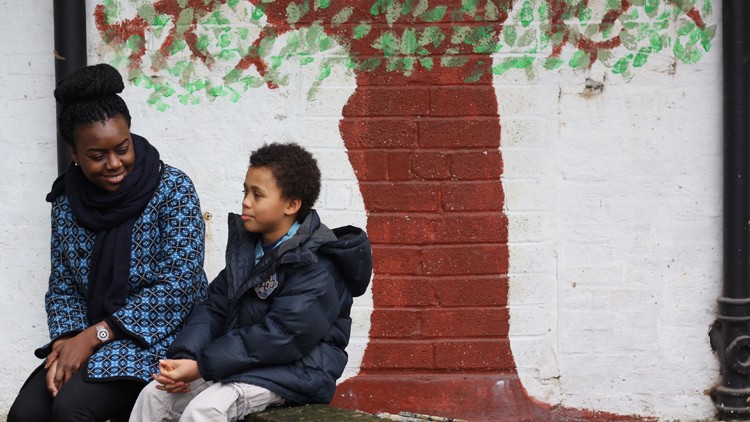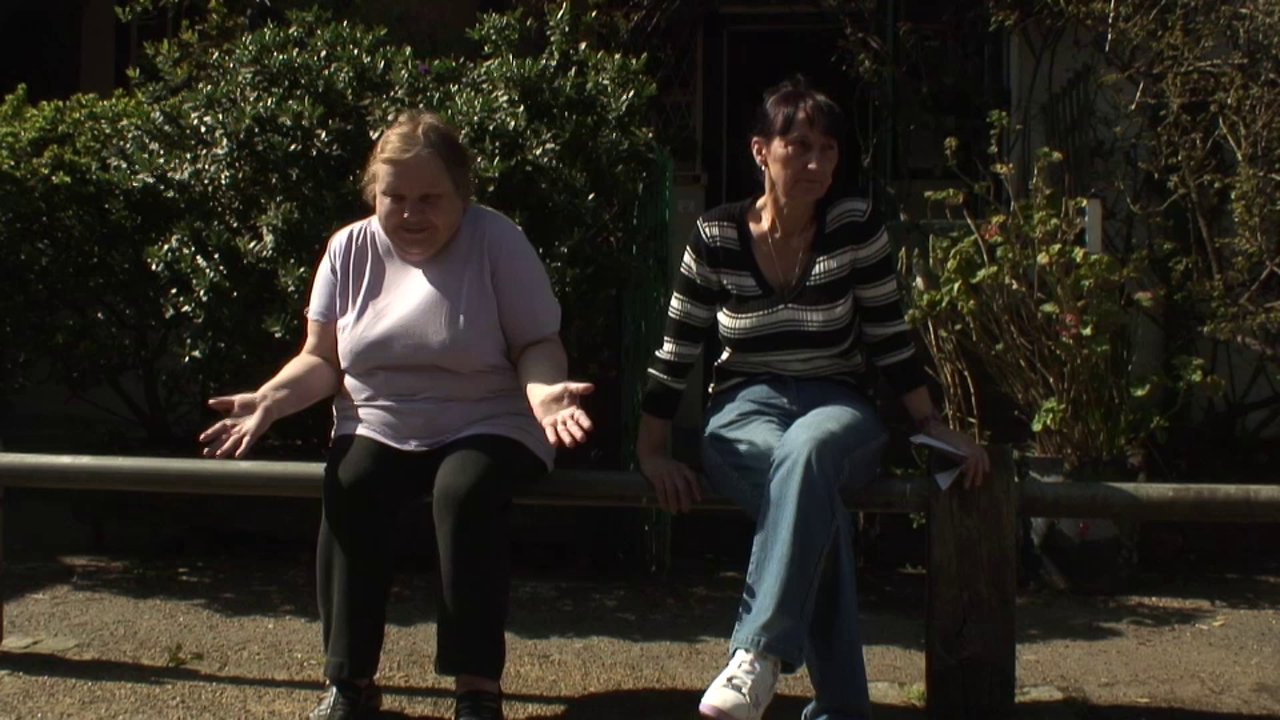24 November – 1 December
Andrea Luka Zimmerman
Merzschmerz (2014)
MerzSchmerz: Lucky Hans, Andrea Luka Zimmerman 2014
Merzschmerz: The Good Man, Andrea Luka Zimmerman 2014
Merzschmerz: The Flying Fish, (1944), Andrea Luka Zimmerman, 2014
Merzschmerz: Once Upon A Time There Was A Tiny Mouse (1941- 1946)’, Andrea Luka Zimmerman 2014
Merzschmerz was commissioned by Film and Video Umbrella for the project MerzBank. Supported by Arts Council England. More information on Merzchmerz available here, along with more information about MerzBank available here.
SYNOPSISS
“Four short films that were shot on the Haggesdon estate with people who feature in Towards Estate and Estate, A Reverie. They are a reversal of traditional stories, questions who tells what, or is allowed to tell what; there is an inverting of normal authorities, where the children are telling the adults adult fairytales…and Schwitters is all about that fucking up of meaning and hierarchies of experience, yet always grounded in the real experience, of sharing.
Fairy tales are handed down from mothers to daughters, and from fathers to sons. As they are passed on, the tales grow in the telling – or gradually depart from the original, as new elements get added, or others get cut. Steeped in memories of childhood, nursery rhymes and other bedside stories seem to speak with the authentic voice of pre-history, and forge a direct link to that bygone past. Although this is an enchanting notion, the reality is that these age-old fables are always something of a patchwork: the product of different authors, at different times.
The party line about Kurt Schwitters was that he was many things: poet, performer, painter, prankster (and permutations of the above). It’s less often noted that he was also a writer of children’s stories – a playful, avuncular spirit with a penchant for the macabre and the absurd. A number of Schwitters’ children’s tales form the basis of Merzschmerz, a series of short videos in which children revisit what they remember of each recently-read story, and relay it in the company of an adult (family member, neighbour, guardian or friend). As the children furrow their brows in concentration, or smirk in advance at the funny things they are about to impart, their excited faces are echoed by the indulgent, quizzical smiles of the adults, creating a moment of togetherness, and adding to the pieces’ infectious charm.”
Text courtesy of of Andrea Luka Zimmerman
Andrea Luka Zimmerman
Towards Estate,
2012, 15′
SYNOPSIS
Towards Estate (2012) is a short film assembled from the diverse elements of the long term production of the Estate feature project, edited in its own terms concisely to relate several of the narratives of Haggerston estate, historically and in the present.
Capturing a moment of imminent transition, Towards Estate (15min, 2012) reflects on urgent matters of regeneration, gentrification and architecture; its reasons, possibilities and consequences. But more importantly, it is a film about time and place, and the ability of holding forms of dreaming and the capacity for wonder within ongoing and growing daily systemic pressures. During this moment of transition (in social and architectural terms), where one structure has broken down, and a new one is about to emerge, another space unfolds; a space of proposals, of uncertainty, and of absolute initiative. In this opening, how might we ask important questions of our ideas of home, of history, always in the making, and of our capacity for an ambition of the imagination in straitened times; that which influences not only how we’re seen, but also how we see; how we dream…
ESTATE, A REVERIE
Estate, A Reverie (2014) tracks the passing of the Haggerston Estate (1938-2014) in Hackney and the utopian promise of social housing it offered, with an unruly celebration of extraordinary everyday humanity. Filmed over seven years, Estate, A Reverie seeks to reveal and celebrate the resilience of residents who are profoundly overlooked by media representations and wider social responses. Interweaving intimate portraits with the residents’ own historical re-enactments and dramatised scenes, the film asks how we might resist being framed exclusively through class, gender, ability or disability, and through geography even?
More information about the project here
Estate, a Reverie, will be shown again at the RIO cinema in the 10th January, 2.30 – Book tickets here
I AM HERE
i am here is a public art work generated from within an increasingly transformed residential area in Hackney, East London. It is a direct response to the experience of living in an estate in the process of being regenerated. The Haggerston estate, and Samuel House, is located alongside Regents Canal in-between Kingsland Road and Victoria Park in Hackney, London.
More information about the project here
FUGITIVE IMAGES
Fugitive Images are Andrea Luka Zimmerman, Lasse Johansson and David Roberts.
Fugitive Images platform grew out of a desire to capture the peculiar moment of the place where they live and work immediately prior to it being demolished. Haggerston Estate is suspended somewhere between it first being occupied in the 1930’s and imminent demolition in 2009 (second phase of demoloition is in 2013), a place in transformation, in wait.
More information about the project here
BIOGRAPHY
Andrea Luka Zimmerman is a filmmaker, artist and cultural activist. Andrea grew up in the largest council estate in Munich and left school at 16 to become a hairdresser. After coming to London in 1991, she went on an Access course at Tower Hamlets College.
She won the 2014 Artangel Open award for her collaborative project Cycle with Adrian Jackson (of Cardboard Citizens). Her feature essay film Taskafa: Stories of the Street (66mins, 2013), a film about resistance and co-existence and voiced by John Berger, from his novel King, is told through the lives of the street dogs of Istanbul. It premiered at the city’s international film festival, and in the UK at the London Film Festival.
She is co-founder of the artists’ collective Fugitive Images (responsible for the photographic installation i am here and the artists’ book-work Estate: Arts, Politics and Social Housing in Britain). Her forthcoming feature essay film Estate tracks the passing of the Haggerston Estate in Hackney, London and the utopian promise of social housing it offered, with an unruly celebration of extraordinary everyday humanity.
Filmed over seven years, Estate, a Reverie seeks to reveal and celebrate the resilience of residents who are profoundly overlooked by media representations and wider social responses. Interweaving intimate portraits with the residents’ own historical re-enactments and dramatised scenes, Estate, a Reverie asks how we might resist being framed exclusively through class, gender, ability or disability, and through geography even.
She was a founding member of Vision Machine, which worked in the USA and Indonesia, exploring the impact of globalisation, power, and denied histories. She has presented widely on her work and its concerns at numerous conferences, symposia, film festivals, cinemas, and cultural/activist spaces within the UK and internationally.
Her PhD (University of the Arts London, 2007) examined the relationship between spectacular (Hollywood) and spectral (covert and special military operations) representations of political violence. From this period developed her essay-film ID – Prisoner of War (2015), which investigates US militarism and foreign policy through a character study of one of its most enduring rogue agents.
LINKS

